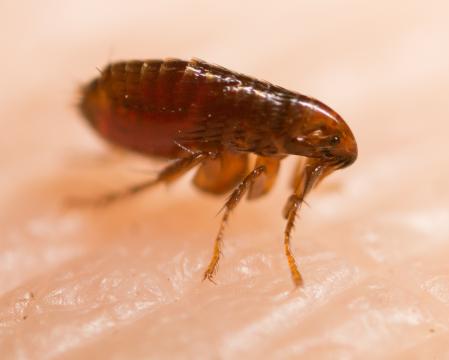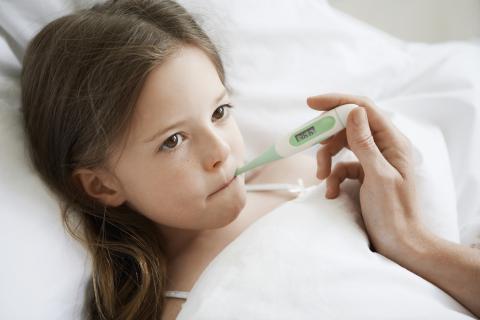Plague
Plague is an illness caused by the bacterium Yersinia pestis. It is usually spread to humans through the bites of infected fleas.
Although a handful of people in the western United States become infected each year, plague has never been reported in Wisconsin.
There are different forms of plague depending on how a person came into contact with the bacteria. The most common forms are bubonic, pneumonic, and septicemic.
- Bubonic plague is usually caused by the bite of an infected flea.
- Septicemic plague can be caused by bites from infected fleas or handling infected animals and can occur as the first symptoms of plague. It may also develop if bubonic plague goes untreated.
- Pneumonic plague is usually caused by inhaling respiratory droplets from an infected person, or may develop when untreated bubonic or septicemic plague has spread to the lungs.
Plague 101
People can get plague by:
- Being bitten by infected fleas. This causes both bubonic and septicemic plague.
- This is the most common way humans become infected with plague.
- Fleas become infected with plague by feeding on rodents, such as chipmunks, prairie dogs, ground squirrels, mice, and other mammals, that are infected with the Yersinia pestis bacterium.
- Infected fleas can then spread the bacteria when they bite humans.
- Being bitten or scratched by infected animals or handling carcasses of animals that were infected.
- This is less common, and happens most often through contact with infected rodents, such as rabbits.
- It is important to be careful when handling any sick or dead animal.
- Breathing in respiratory droplets from a coughing person who has pneumonic plague.
Signs and symptoms of plague are different depending on the form
Symptoms of bubonic plague
- Sudden onset of fever
- Headache
- Chills
- Extreme tiredness
- Weakness
- Swollen, painful lymph nodes (called buboes)
- Swollen lymph nodes in the area of the body near where the bacteria entered
The bacteria multiply in the lymph node closest to where the bacteria enter the body. If left untreated, the bacteria can spread to other parts of the body, and cause severe illness and death.
Symptoms of septicemic plague
- Fever
- Chills
- Extreme weakness
- Abdominal pain
- Shock
- Bleeding into the skin and other organs
- Black, dead skin on fingers, toes, and the nose
Symptoms of pneumonic plague
- Fever
- Headache
- Weakness
- Pneumonia that comes on quickly and can include:
- Shortness of breath
- Chest pain
- Cough
- Bloody or watery mucous
- Shock
- Respiratory failure
Pneumonic plague is the most serious form of the illness and is the only form that can be spread from person to person.
Plague is a very serious illness. If you are experiencing symptoms of plague and live or have traveled to the western U.S. or any other area with plague, it is important to see a doctor immediately. Early treatment with the correct antibiotics is important to prevent complications or death.
Plague can be treated with antibiotics.
Early treatment with the correct antibiotics is important to prevent serious complications and death.
If you are experiencing symptoms of plague and live or have traveled to the western U.S. or any other area with plague, it is important to see a doctor immediately.
Although plague has never been reported in Wisconsin, the following prevention steps can be taken to reduce the risk of becoming infected with plague when spending time in the western U.S. or other areas with plague.
When spending time outdoors
- Avoid rodent burrows and any contact with rodents.
- Use repellent if spending time outdoors in an area with rodent fleas.
- Products containing DEET can be applied to the skin and clothing.
- Products containing permethrin can be applied to clothing only (always follow instructions on the label).
When around your home, work place, or recreational areas
- Reduce rodent habitat by removing brush, rock piles, junk, and woodpiles.
- Remove possible rodent food supplies, such as pet and wild animal food.
- Make your home and outbuildings rodent-proof.
When you have pets
- Use flea control products.
- See a veterinarian as soon as possible if your pet becomes sick.
- Do not allow dogs or cats that roam free in areas with plague to sleep on your bed.
When hunting, trapping, or skinning animals
- Always wear gloves if you are skinning or handling animals, especially rabbits.
- Do not touch your eyes or mouth with dirty hands or gloves.
- Always wash your hands and equipment (knives, cutting boards) after you are done handling the animal.
- Contact your local public health department if you have questions about how to properly dispose of dead animals.
When interacting with animals that could be infected
- Wear protective equipment, such as gloves.
- Avoid bites and scratches.
- Plague Fact Sheet, P-42159 (multiple languages): Fact sheet on plague with information on transmission, symptoms, and prevention.
- Plague: CDC (Centers for Disease Control and Prevention) webpage with general information on symptoms, diagnosis and testing, treatment, and prevention.
Provider information
This is a Wisconsin disease surveillance category I disease:
- Health care providers should report IMMEDIATELY by TELEPHONE to the patient's local public health department upon identification of a confirmed or suspected case.
- Report to the patient's local public health department electronically, through the Wisconsin Electronic Disease Surveillance System (WEDSS), by mail or fax using an Acute and Communicable Disease Case Report, F-44151 (Word) or by other means within 24 hours upon recognition of a case.
- Information on communicable disease reporting
Wisconsin case reporting and public health follow-up guidelines:
Plague EpiNet, P-01918 (PDF): Plague case reporting and investigation protocol for health professionals.
Plague Information for Healthcare Professionals: CDC page with information and resources for clinicians, public health officials, and veterinarians.
Questions about Plague? Contact us!
Phone: 608-267-9003 | Fax: 608-261-4976
Wisconsin Local Health Departments – Regional offices – Tribal agencies



